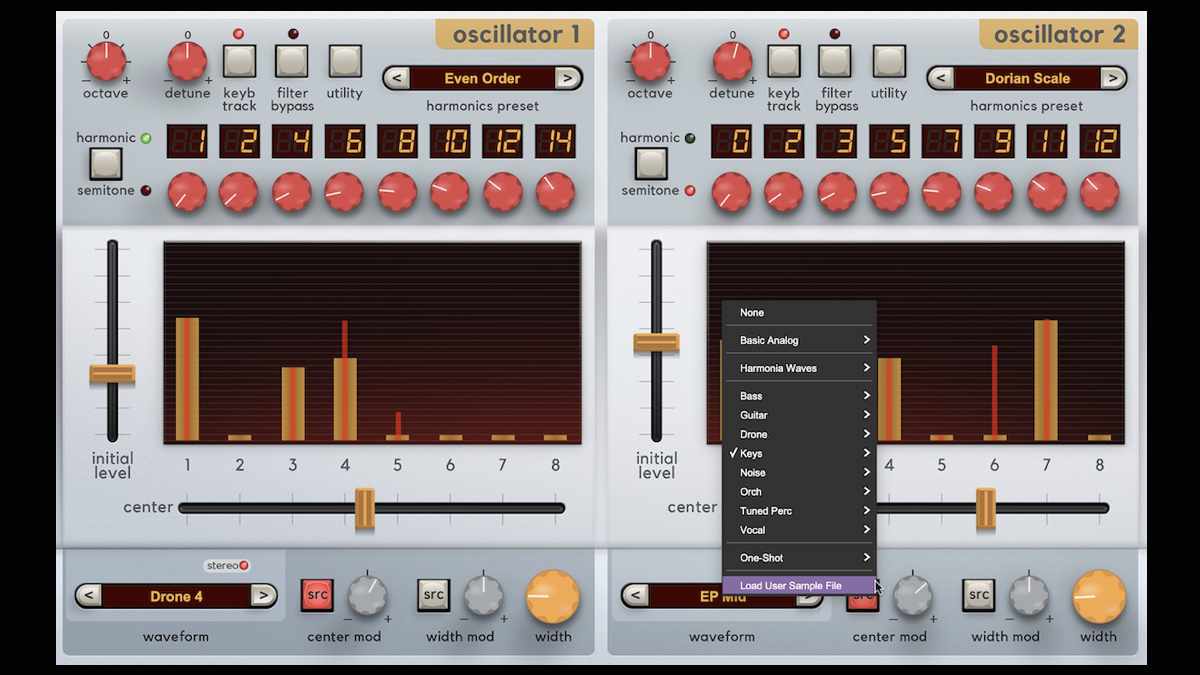Covers
Cherry Audio Harmonia Hybrid Softsynth: The Synth and Software Review

It’s like additive synthesis but unique: two sample-based oscillators play up to eight pitches each, based on the harmonic series or tuned to half-steps
Earlier this week Cherry Audio released Harmonia, their latest synth. If you were wondering whether there’s anything new in synthesis, please read on.
Sampling is great at capturing the nuances of sound, and modern sampling technology goes to great lengths to bring life and animation to its sounds. Additive synthesis – at least in theory – is capable of fine sonic detail but it can sound static, without some means of modulating the spectra.
Cherry Audio’s Harmonia borrows from sampling and additive techniques and adds scanning to the mix, along with some subtractive synthesis features, and remarkably, does so with a simplicity that cuts to the chase, avoiding the complications inherent in a merging of synthesis engines.
Harmonia is not intended for replicating acoustic and electric sounds; you get two oscillators, each of which can load a single WAV file (mono or stereo). It comes with a generous set of useful samples, ranging from basic analog-type waveforms to orchestral, instrumental, and synth-derived tones, as well as unique wavetables provided by Cherry Audio. You can also load in your own WAV files. Once you have selected a sample, you can set its octave, fine-tuning, keyboard tracking, and other typical oscillator modifiers.

Below these amenities, we come to the star of the show: features that vault Harmonia well beyond sample playback synthesis. Each oscillator provides eight boxes for the levels of harmonics of the sample, and you can enter these manually or choose from a variety of presets. By default, you start with harmonics 1 through 8, but any harmonic can have a value between 0 (off) and 37.
You can also toggle semitone frequencies for each harmonic, and choose from a variety of modes. The results are quite different, and often exotic and bizarre. Fans of single-key chordal madness can find near-instant gratification
Below you see the interpolation and modulation section (one for each oscillator). The window resembles organ drawbars, and in fact, it can be used that way if you wish to create organ patches. At the left, you can set the initial level of all harmonics, or you can grab a harmonic and set its level relative to the others. The harmonics are interpolated from the sample and can be modulated in a number of ways.
Paramount to the way the harmonics play back are the Center Frequency and Width parameters; If the Width is set to zero, sweeping the harmonics will produce discrete notes, according to the scale or harmonics you have set up, in the manner of a step sequencer. In fact, you can modulate the center frequency with an LFO, synced to a MIDI clock, and you have an arpeggiated oscillator.
With the Width parameter set to anything greater than zero, the volume of neighboring harmonics increases or decreases, and the transition between harmonics becomes smooth and continuous.
It’s a breeze (and fun) to grab the center frequency slider and quickly alter the timbre of the oscillator. Of course, you can modulate width, center frequency, and much more in a number of ways; Harmonia’s modulation matrix is rich and flexible.
My few druthers include multisegmented envelope generators (one per oscillator) for amplitude and filter as well as an auxiliary, freely assignable one.
If all of this seems complicated and divorced from the norms of sample-based, subtractive synthesis, it really isn’t. Everything happens in real time, and it’s the perfect synth for kinetic learners: just grab a control and listen. Multiple undo commands await at the instrument’s header should you take a wrong turn. This brings me to a complaint: I hope that someday, Cherry Audio will see fit to provide a more vision-friendly contrast for the characters in the header. This is true for all of their synths. Thankfully it’s easy to resize, and Cherry Audio’s Focus button lets you home in on the details without invoking eyestrain.
Finally, Harmonia’s library of presets is often gorgeous and animated, evoking the sweeping, cascading beauty of many of the revered synths of recent memory, albeit accomplished without stitching multisamples together. This is something altogether different, and I recommend it highly.
















